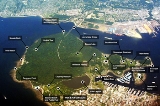
Stanley Park
Encyclopedia
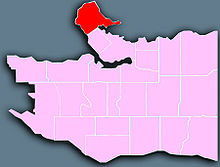
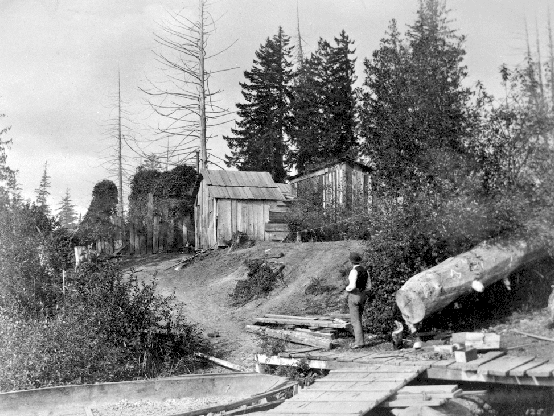
Hectare
The hectare is a metric unit of area defined as 10,000 square metres , and primarily used in the measurement of land. In 1795, when the metric system was introduced, the are was defined as being 100 square metres and the hectare was thus 100 ares or 1/100 km2...
(1,001 acre) urban park
Urban park
An urban park, is also known as a municipal park or a public park, public open space or municipal gardens , is a park in cities and other incorporated places to offer recreation and green space to residents of, and visitors to, the municipality...
bordering downtown Vancouver
Vancouver
Vancouver is a coastal seaport city on the mainland of British Columbia, Canada. It is the hub of Greater Vancouver, which, with over 2.3 million residents, is the third most populous metropolitan area in the country,...
, British Columbia
British Columbia
British Columbia is the westernmost of Canada's provinces and is known for its natural beauty, as reflected in its Latin motto, Splendor sine occasu . Its name was chosen by Queen Victoria in 1858...
, Canada
Canada
Canada is a North American country consisting of ten provinces and three territories. Located in the northern part of the continent, it extends from the Atlantic Ocean in the east to the Pacific Ocean in the west, and northward into the Arctic Ocean...
. It was opened in 1888 by David Oppenheimer in the name of Lord Stanley of Preston
Frederick Stanley, 16th Earl of Derby
Frederick Arthur Stanley, 16th Earl of Derby KG, GCB, GCVO, PC , known as Frederick Stanley until 1886 and as Lord Stanley of Preston between 1886 and 1893, was a Conservative Party politician in the United Kingdom who served as Colonial Secretary from 1885 to 1886 and the sixth Governor General...
, the Governor-General of Canada.
It is more than 10% larger than New York City's Central Park
Central Park
Central Park is a public park in the center of Manhattan in New York City, United States. The park initially opened in 1857, on of city-owned land. In 1858, Frederick Law Olmsted and Calvert Vaux won a design competition to improve and expand the park with a plan they entitled the Greensward Plan...
and almost half the size of London's Richmond Park
Richmond Park
Richmond Park is a 2,360 acre park within London. It is the largest of the Royal Parks in London and Britain's second largest urban walled park after Sutton Park, Birmingham. It is close to Richmond, Ham, Kingston upon Thames, Wimbledon, Roehampton and East Sheen...
. The park attracts an estimated eight million visitors every year, including locals and tourists, who come for its recreational facilities and its natural attributes. A paved 8.8 kilometres (5.5 mi) seawall
Seawall (Vancouver)
The seawall in Vancouver, Canada is a stone wall that was constructed around the perimeter of Stanley Park to prevent the erosion of the park's foreshore. Colloquially, the term also denotes the pedestrian, bicycle, and roller blading pathway on the seawall, and which has been extended far outside...
path circles the park, which is used by 2.5 million pedestrians, cyclists, and inline skaters every year. Much of the park remains forested with an estimated half million trees, some of which stand as tall as 76 metres (249.3 ft) and are up to hundreds of years old.
There are approximately 200 kilometres (124.3 mi) of trails and roads in the park, which are patrolled by the Vancouver Police Department
Vancouver Police Department
The Vancouver Police Department is the police force for the City of Vancouver in British Columbia, Canada. It is one of several police departments within the Metro Vancouver Area and is the second largest police force in the province after RCMP "E" Division.VPD was the first Canadian police force...
's equine
Horse
The horse is one of two extant subspecies of Equus ferus, or the wild horse. It is a single-hooved mammal belonging to the taxonomic family Equidae. The horse has evolved over the past 45 to 55 million years from a small multi-toed creature into the large, single-toed animal of today...
mounted squad. The Project for Public Spaces
Project for Public Spaces
Project for Public Spaces is a nonprofit organization based in New York dedicated to creating and sustaining public places that build communities. Planning and design rooted in the community form the cornerstone of PPS’s work. Building on the techniques of William H...
has ranked Stanley Park as the sixteenth best park in the world and sixth best in North America.
History
The area of the park is the traditional territory of several different indigenous tribes. On the Burrard InletBurrard Inlet
Burrard Inlet is a relatively shallow-sided coastal fjord in southwestern British Columbia, Canada. Formed during the last Ice Age, it separates the City of Vancouver and the rest of the low-lying Burrard Peninsula from the slopes of the North Shore Mountains, home to the communities of West...
and Howe Sound
Howe Sound
Howe Sound is a roughly triangular sound, actually a network of fjords situated immediately northwest of Vancouver.-Geography:Howe Sound's mouth at the Strait of Georgia is situated between West Vancouver and the Sunshine Coast. The sound is triangular shaped, open on its southeast towards the...
regions, Squamish had many villages in this park. On the lower Fraser River
Fraser River
The Fraser River is the longest river within British Columbia, Canada, rising at Fraser Pass near Mount Robson in the Rocky Mountains and flowing for , into the Strait of Georgia at the city of Vancouver. It is the tenth longest river in Canada...
area, Musqueam used the area for resource gathering. Where Lumberman's Arch is now in Stanley Park, a large Squamish village once presided called X̱wáýx̱way meaning Place of masks. The dwellings traditionally used was a longhouse built from cedar poles and slabs. One longhouse was measured at 200 feet (61 m) long by 60 feet (18.3 m) wide. These houses were occupied by large extended families living in different quadrants of the house. The larger houses were used to ceremonial potlatch
Potlatch
A potlatch is a gift-giving festival and primary economic system practiced by indigenous peoples of the Pacific Northwest Coast of Canada and United States. This includes Heiltsuk Nation, Haida, Nuxalk, Tlingit, Makah, Tsimshian, Nuu-chah-nulth, Kwakwaka'wakw, and Coast Salish cultures...
s where a host would invite guests to witness and participate in ceremonies and the giving away of property.
The park itself was a rich resource for gathering food and materials. The Squamish "cut down large cedar trees in Stanley Park for making canoes and other purposes" utilizing "nothing but stone chisels and a big round stone for a hammer." Where present Second Beach is, a place called "St’i’tekekw’" to Squamish was used to gather "a clay material or muddy substance formally obtained right in the bed of a small creek... which, when rolled into loaves, as (my people) did it, and heated or roasted before a fire, turned into a white like chalk" This material was used in the making of mountain goat wool and dog wool blankets. The Squamish name references this material. Another home for local natives was where present Prospect Point is. This place is called "Schi'lhus" meaning High Bluff. Coal Harbour
Coal Harbour
Coal Harbour is the name for a section of Burrard Inlet lying between Vancouver, Canada's downtown peninsula and the Brockton Peninsula of Stanley Park...
was known as a fishing spot for herring. August Jack, a local historian who once lived at Schi’lhus, remembered his early days when him and his brother were "fish-raking in Coal Harbor" and "got lots of herring in (the) canoe". Deadman's Island
Deadman's Island (Vancouver)
Deadman Island is a 3.8 ha island to the south of Stanley Park in Coal Harbour in Vancouver, British Columbia. The indigenous Sḵwxwú7mesh name is "skwtsa7s", meaning simply "island." Officially designated "Deadman Island" by the Geographical Names Board of Canada in 1937. it is commonly referred to...
(properly called Deadman Island on official charts and maps) located in Coal Harbour was once used a burial island, possibly a reason for its macabre name. The popular landmark Siwash Rock
Siwash Rock
Siwash Rock is a famous rock outcropping in Vancouver, British Columbia, Canada's Stanley Park. A legend among the Indigenous Squamish surrounds the of the rock...
is called "Slah-kay-ulsh" meaning "he is standing up." In their oral history, a man was transformed into this rock by the three Transformer brothers. The hole in the rock was where Slah-kay-ulsh kept his fishing tackle, according to Andrew Paull
Andy Paull
Andy Paull, was a Sḵwxwú7mesh leader, activist, coach, and lawyer.-Early life and family:...
.
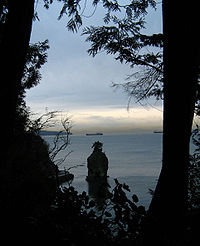
José María Narváez
José María Narváez was a Spanish naval officer, explorer, and navigator notable for his work in the Pacific Northwest of present-day Canada. In 1791, as commander of the schooner Santa Saturnina, he led the first European exploration of the Strait of Georgia, including a landing on present-day...
and British Captain George Vancouver
George Vancouver
Captain George Vancouver RN was an English officer of the British Royal Navy, best known for his 1791-95 expedition, which explored and charted North America's northwestern Pacific Coast regions, including the coasts of contemporary Alaska, British Columbia, Washington and Oregon...
. Captain Vancouver recorded in his journal "Here we met about fifty Indian's, in their canoes, who conducted themselves with the greatest decorum and civility, presenting us with many cooked fish, and undressed, of the sort already mentioned as resembling the smelt. These good, people, finding we were inclined to make some return for their hospitality, shewed much understanding in preferring copper to iron." In his A Voyage of Discovery, Vancouver describes the area as “an island ... with a smaller island [Deadman's Island] lying before it,” indicating that it was originally surrounded by water, at least at high tide. No other contact was recorded for decades, until around the time of the Crimean War
Crimean War
The Crimean War was a conflict fought between the Russian Empire and an alliance of the French Empire, the British Empire, the Ottoman Empire, and the Kingdom of Sardinia. The war was part of a long-running contest between the major European powers for influence over territories of the declining...
when British admirals
Royal Navy
The Royal Navy is the naval warfare service branch of the British Armed Forces. Founded in the 16th century, it is the oldest service branch and is known as the Senior Service...
arranged with Sḵwx̱wú7mesh Joe Capilano
Joe Capilano
Joe Capilano , was a leader of the Sḵwxwú7mesh , who called him Sa7plek . He fought for the recognition of Native rights and lifestyle.Capilano spent his youth fishing and hunting...
that in the case of an invasion, the British would defend the south shore of Burrard Inlet
Burrard Inlet
Burrard Inlet is a relatively shallow-sided coastal fjord in southwestern British Columbia, Canada. Formed during the last Ice Age, it separates the City of Vancouver and the rest of the low-lying Burrard Peninsula from the slopes of the North Shore Mountains, home to the communities of West...
and the Squamish would defend the north.
According to Capilano’s daughter, the British gave him and his men 60 musket
Musket
A musket is a muzzle-loaded, smooth bore long gun, fired from the shoulder. Muskets were designed for use by infantry. A soldier armed with a musket had the designation musketman or musketeer....
s. Although the attack anticipated by the British never came, the guns were used by the Sḵwx̱wú7mesh to repel an attack by an indigenous raid from the north. Stanley Park was not attacked but this was the beginning of it being considered a strategic military location by the British.
The peninsula
Peninsula
A peninsula is a piece of land that is bordered by water on three sides but connected to mainland. In many Germanic and Celtic languages and also in Baltic, Slavic and Hungarian, peninsulas are called "half-islands"....
was designated as a military reserve in the early 1860s in a survey conducted by the Royal Engineers
Royal Engineers
The Corps of Royal Engineers, usually just called the Royal Engineers , and commonly known as the Sappers, is one of the corps of the British Army....
. It was again considered a strategic point in case Americans might attempt an invasion and launch an attack on New Westminster (then the colonial capital) via Burrard Inlet. Although the area was logged by six different companies between the 1860s and 1880s, this military designation saved the land from development. In 1886, as its first order of business, Vancouver’s City Council voted to petition the Dominion
Government of Canada
The Government of Canada, formally Her Majesty's Government, is the system whereby the federation of Canada is administered by a common authority; in Canadian English, the term can mean either the collective set of institutions or specifically the Queen-in-Council...
government to lease the reserve for use as a park.
To manage their new acquisition, city council appointed a six-man park committee, which was replaced with the Vancouver Park Board
Vancouver Park Board
The Vancouver Park Board is an elected board with exclusive possession, jurisdiction and control over public parks in the City of Vancouver. Established by section 485 of the Vancouver Charter, the Park Board , is one of the only elected bodies of its kind in Canada...
in 1890 that was to be elected rather than appointed (a rarity in North American cities). The Vancouver Park Board manages 192 parks on over 12.78 square kilometres (3,158 acre) of land, but Stanley Park remains by far the largest.
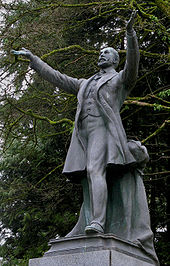
Frederick Stanley, 16th Earl of Derby
Frederick Arthur Stanley, 16th Earl of Derby KG, GCB, GCVO, PC , known as Frederick Stanley until 1886 and as Lord Stanley of Preston between 1886 and 1893, was a Conservative Party politician in the United Kingdom who served as Colonial Secretary from 1885 to 1886 and the sixth Governor General...
, Governor General of Canada
Governor General of Canada
The Governor General of Canada is the federal viceregal representative of the Canadian monarch, Queen Elizabeth II...
at the time. The following year, Lord Stanley became the first Governor General
Governor General of Canada
The Governor General of Canada is the federal viceregal representative of the Canadian monarch, Queen Elizabeth II...
to visit British Columbia when he officially dedicated the park. An observer at the event wrote:
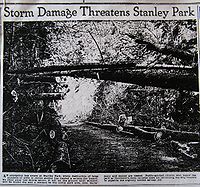
In 1908, twenty years after the first petition for the lease, the federal government renewed the lease of Stanley Park to Vancouver
Vancouver
Vancouver is a coastal seaport city on the mainland of British Columbia, Canada. It is the hub of Greater Vancouver, which, with over 2.3 million residents, is the third most populous metropolitan area in the country,...
for ninety-nine years, renewable in 2007. and rolled over in 2008.
Deadman's Island
Deadman's Island (Vancouver)
Deadman Island is a 3.8 ha island to the south of Stanley Park in Coal Harbour in Vancouver, British Columbia. The indigenous Sḵwxwú7mesh name is "skwtsa7s", meaning simply "island." Officially designated "Deadman Island" by the Geographical Names Board of Canada in 1937. it is commonly referred to...
, a small island off Stanley Park is the site of Vancouver's Naval Reserve Division HMCS Discovery
HMCS Discovery
HMCS Discovery is a Royal Canadian Navy Reserve division and shore facility based in Vancouver, British Columbia. Created during World War II from the Vancouver Half Company of the Royal Naval Canadian Volunteer Reserve, Discovery was used for recruitment and training, and provided almost 8,000...
. During the 1860s to early 1880s, early settlers along Burrard Inlet also used the island, along with Brockton Point, as a burial ground and cemetery. Burials ceased when the Mountain View Cemetery
Mountain View Cemetery (Vancouver)
Mountain View Cemetery is the oldest cemetery in the City of Vancouver, British Columbia. Opened in 1887, it is located west of Fraser Street between 31st and 43rd Avenues...
opened in 1887, just after Vancouver had become a city. During a small pox outbreak in the late 1880s, Deadman Island became a "pest house" for quarantined victims of the disease and burial site for those who did not survive.
The park was designated a National Historic Site of Canada by the federal government in 1988. It was deemed significant because the relationship between its "natural environmental and its cultural elements developed over time" and because "it epitomizes the large urban park in Canada."
Squamish First Nations
First Nations
First Nations is a term that collectively refers to various Aboriginal peoples in Canada who are neither Inuit nor Métis. There are currently over 630 recognised First Nations governments or bands spread across Canada, roughly half of which are in the provinces of Ontario and British Columbia. The...
Chief Ian Cambell proposed in 2010 renaming Stanley Park as Xwayxway Park after the large village formerly located in the area.
World War I
A small temporary gun battery was established above Siwash Rock to protect Vancouver from possible attacks from German merchant raiders. Removed prior to the end of the war.World War II
With the threat of a Japanese attack high on peoples' minds, a gun battery with two 6” Mk7 guns on Mk 2 mountings were emplaced at Third beach. Later the 6” guns were replaced by 4” guns. Remains of the emplacement can still be seen, but the bunker has been buried. The Teahouse restaurant is just behind the emplacement and was the mess for the crews serving the guns. The battery was demobilized at the end of the war. Also a searchlight tower was built above Siwash rock and remains intact on the cliff above.Attractions
Stanley Park contains numerous natural and man-made attractions that lure visitors to the park. Unlike other large urban parks, Stanley Park is not the product of a landscape architectLandscape architect
A landscape architect is a person involved in the planning, design and sometimes direction of a landscape, garden, or distinct space. The professional practice is known as landscape architecture....
, but has evolved into its present, mixed-use configuration.
Forest
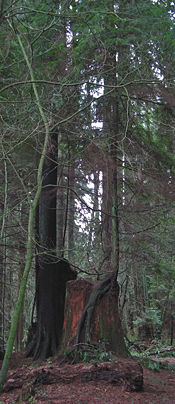
Oasis
In geography, an oasis or cienega is an isolated area of vegetation in a desert, typically surrounding a spring or similar water source...
. It is primarily second and third growth and contains many huge Douglas-fir
Douglas-fir
Douglas-fir is one of the English common names for evergreen coniferous trees of the genus Pseudotsuga in the family Pinaceae. Other common names include Douglas tree, and Oregon pine. There are five species, two in western North America, one in Mexico, and two in eastern Asia...
, Western Red cedar
Thuja plicata
Thuja plicata, commonly called Western or pacific red cedar, giant or western arborvitae, giant cedar, or shinglewood, is a species of Thuja, an evergreen coniferous tree in the cypress family Cupressaceae native to western North America...
, Western Hemlock
Tsuga
Tsuga is a genus of conifers in the family Pinaceae. The common name hemlock is derived from a perceived similarity in the smell of its crushed foliage to that of the unrelated plant poison hemlock....
, and Sitka Spruce
Sitka Spruce
Picea sitchensis, the Sitka Spruce, is a large coniferous evergreen tree growing to 50–70 m tall, exceptionally to 95 m tall, and with a trunk diameter of up to 5 m, exceptionally to 6–7 m diameter...
trees.

Another storm
Hanukkah Eve Wind Storm of 2006
The Hanukkah Eve Wind Storm of 2006 was a powerful Pacific storm that slammed into the Pacific Northwest region of the United States and southern British Columbia, Canada between December 14, 2006 and December 15, 2006...
ravaged the park on December 15, 2006 with 115 kilometres per hour (71.5 mph) winds. Over 60% of the western edge was damaged; the worst part was the area around Prospect Point. In total, about 40% of the forest was affected, with an estimated 3,000 trees damaged. Large sections of the seawall were also destabilized by the storm, and many areas of the park were closed to the public pending restoration. The cost of restoration has been estimated at $9 million, which will be covered by contributions from all three levels of government and private and corporate donations.
Since 1992, the tallest trees have been topped and otherwise pruned by park staff for safety reasons.
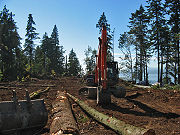

Siwash Rock
Siwash Rock is a famous rock outcropping in Vancouver, British Columbia, Canada's Stanley Park. A legend among the Indigenous Squamish surrounds the of the rock...
has also been memorialized with a replacement. The original died in the dry summer of 1965, and through the persistent efforts of park staff, a replacement finally took root in 1968.
Bodies of water
In addition to being nearly surrounded by the Pacific OceanPacific Ocean
The Pacific Ocean is the largest of the Earth's oceanic divisions. It extends from the Arctic in the north to the Southern Ocean in the south, bounded by Asia and Australia in the west, and the Americas in the east.At 165.2 million square kilometres in area, this largest division of the World...
, Stanley Park is home to several other bodies of water in Vancouver
Bodies of water in Vancouver
Vancouver, British Columbia, Canada is home to several bodies of water within and around its boundaries.Of over 30 historically salmon-bearing streams diverted into underground culverts due to urbanization, several have been restored to a state visible and habitable again by plants and...
. Beaver Lake is a small lake, mostly covered by lily pad
Nymphaeaceae
Nymphaeaceae is a family of flowering plants. Members of this family are commonly called water lilies and live in freshwater areas in temperate and tropical climates around the world. The family contains eight genera. There are about 70 species of water lilies around the world. The genus...
s, home to fish and water birds. As of 1997, its surface area was 3.95 hectares, but the lake is slowly shrinking in size. One of Vancouver's few remaining free-flowing streams, Beaver Creek, joins Beaver Lake to the Pacific Ocean and is one of two streams in Vancouver where salmon
Salmon
Salmon is the common name for several species of fish in the family Salmonidae. Several other fish in the same family are called trout; the difference is often said to be that salmon migrate and trout are resident, but this distinction does not strictly hold true...
still return to spawn
Spawn (biology)
Spawn refers to the eggs and sperm released or deposited, usually into water, by aquatic animals. As a verb, spawn refers to the process of releasing the eggs and sperm, also called spawning...
each year.
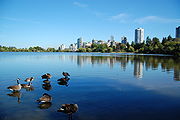
Lost Lagoon
Lost Lagoon is an artificial, captive 16.6-hectare body of water, west of Georgia Street, near the entrance to Stanley Park in Vancouver, Canada. Surrounding the lake is a trail, and it features a lit fountain that was erected by Robert Harold Williams to commemorate the city's golden jubilee...
is a captive 16.6 hectare (41 acre) body of water, west of Georgia Street
Georgia Street
Georgia Street is an east-west street in the cities of Vancouver and Burnaby, British Columbia, Canada. Its section in Downtown Vancouver, designated West Georgia Street, serves as one of the primary streets for the financial and central business districts, and is the major transportation corridor...
, near the Georgia Street entrance to the park. Surrounding the lake is a 1.75 kilometres (1.1 mi) trail, and it features a lit fountain that was erected to commemorate the city's golden jubilee. It is a nesting ground to many species of bird, including swan
Swan
Swans, genus Cygnus, are birds of the family Anatidae, which also includes geese and ducks. Swans are grouped with the closely related geese in the subfamily Anserinae where they form the tribe Cygnini. Sometimes, they are considered a distinct subfamily, Cygninae...
, Canada goose
Canada Goose
The Canada Goose is a wild goose belonging to the genus Branta, which is native to arctic and temperate regions of North America, having a black head and neck, white patches on the face, and a brownish-gray body....
, duck
Duck
Duck is the common name for a large number of species in the Anatidae family of birds, which also includes swans and geese. The ducks are divided among several subfamilies in the Anatidae family; they do not represent a monophyletic group but a form taxon, since swans and geese are not considered...
, beaver
Beaver
The beaver is a primarily nocturnal, large, semi-aquatic rodent. Castor includes two extant species, North American Beaver and Eurasian Beaver . Beavers are known for building dams, canals, and lodges . They are the second-largest rodent in the world...
and great blue heron
Great Blue Heron
The Great Blue Heron is a large wading bird in the heron family Ardeidae, common near the shores of open water and in wetlands over most of North and Central America as well as the West Indies and the Galápagos Islands. It is a rare vagrant to Europe, with records from Spain, the Azores and England...
.
Recreational facilities
Recreational facilities are abundant in the park, having long co-existed, albeit uneasily, with the aesthetic and more natural park features preferred by those looking to the park as an enclave of nature in the city. The most heavily used and the favourite facility of park users is the seawallSeawall (Vancouver)
The seawall in Vancouver, Canada is a stone wall that was constructed around the perimeter of Stanley Park to prevent the erosion of the park's foreshore. Colloquially, the term also denotes the pedestrian, bicycle, and roller blading pathway on the seawall, and which has been extended far outside...
encircling the park’s perimeter. Construction of the 8.8 kilometres (5.5 mi) seawall around the park began in 1917, but was not declared finished until September 26, 1971, and did not fully circle the park until 1980.
James "Jimmy" Cunningham, a master mason, dedicated 32 years of his life to the construction of the seawall from 1931 until his retirement in 1963. Even after he retired, Cunningham continued to return (once in his pajamas) to monitor the wall's progress, until his death at 85 on September 29, 1963.
The seawall is a popular destination for walking
Walking
Walking is one of the main gaits of locomotion among legged animals, and is typically slower than running and other gaits. Walking is defined by an 'inverted pendulum' gait in which the body vaults over the stiff limb or limbs with each step...
, running
Running
Running is a means of terrestrial locomotion allowing humans and other animals to move rapidly on foot. It is simply defined in athletics terms as a gait in which at regular points during the running cycle both feet are off the ground...
, cycling
Cycling
Cycling, also called bicycling or biking, is the use of bicycles for transport, recreation, or for sport. Persons engaged in cycling are cyclists or bicyclists...
, and inline skating
Inline skating
Inline skating is a recreational sport practiced widely internationally. Inline skates typically have 2 to 5 polyurethane wheels, arranged in a single line. The in-line design allows for greater speed than roller skates and better maneuverability...
. There are two paths, one for inline skaters and cyclists and the other for pedestrians. The section around the outside of the park is one-way for cyclists and inline skaters, running counter-clockwise. The walkway has been extended several times and is currently 22 kilometres from end to end, making it the world's longest uninterrupted waterfront walkway. Unofficially, it starts at Canada Place
Canada Place
Canada Place is a building situated on the Burrard Inlet waterfront of Vancouver, British Columbia. It is the home of the Vancouver Convention Centre, the Pan Pacific Hotel, Vancouver's World Trade Centre, and the world's first permanent IMAX 3D theatre . The building's exterior is covered by...
in the downtown core, runs around Stanley Park, along English Bay beach, around False Creek
False Creek
False Creek is a short inlet in the heart of Vancouver. It separates downtown from the rest of the city. It was named by George Henry Richards during his Hydrographic survey of 1856-63. Science World is located at its eastern end and the Burrard Street Bridge crosses its western end. False Creek is...
, and finally to Kitsilano Beach
Kitsilano Beach
Kitsilano Beach is one of the most popular beaches in Vancouver, especially in the warm summer months. Located at the north edge of the Kitsilano neighbourhood, the beach faces out onto Burrard Inlet...
. From there, a trail continues 600 metres to the west, connecting to an additional 12 kilometres of beaches and pathways which terminate at the mouth of the Fraser River
Fraser River
The Fraser River is the longest river within British Columbia, Canada, rising at Fraser Pass near Mount Robson in the Rocky Mountains and flowing for , into the Strait of Georgia at the city of Vancouver. It is the tenth longest river in Canada...
. The December 2006 storm subjected parts of the park portion of the seawall to mudslides and falling debris, forcing park staff to close it for an extended repair period.
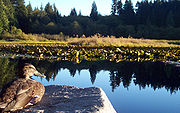
Pitch and putt
Pitch and putt is an amateur sport, similar to golf. The maximum hole length for international competitions is with a maximum total course length of . Players may only use three clubs; one of which must be a putter...
golf course, a seaside swimming pool at Second Beach, and the Brockton Oval for track sports, rugby, and cricket. For entertainment, there is the Aquarium
Vancouver Aquarium
The Vancouver Aquarium Marine Science Centre is a public aquarium located in Stanley Park in Vancouver, British Columbia, Canada. In addition to being a major tourist attraction for Vancouver, the aquarium is a centre for marine research, conservation and marine animal rehabilitation.The Vancouver...
, Canada’s first and largest since it opened in 1956, and the Malkin Bowl, rebuilt after a fire in the 1980s and home to the local Theatre Under the Stars
Theatre Under the Stars (Vancouver)
Theatre Under The Stars, commonly referred to as TUTS, is one of Vancouver's largest musical theatre companies. The society presents two musicals during the summer season at Malkin Bowl in Stanley Park, British Columbia.-History:...
.
Animals
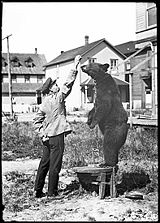
Zoo
A zoological garden, zoological park, menagerie, or zoo is a facility in which animals are confined within enclosures, displayed to the public, and in which they may also be bred....
, which grew out of the collection of animals begun by the first park superintendent (aka Park Ranger, 1888–1896), Henry Avison, after he captured an orphaned black bear cub and chained it to a stump for safety. Avison was subsequently named city pound keeper, and his collection of animals formed the basis for the original zoo, which eventually housed over 50 animals, including snake
Snake
Snakes are elongate, legless, carnivorous reptiles of the suborder Serpentes that can be distinguished from legless lizards by their lack of eyelids and external ears. Like all squamates, snakes are ectothermic, amniote vertebrates covered in overlapping scales...
s, wolves, emu
Emu
The Emu Dromaius novaehollandiae) is the largest bird native to Australia and the only extant member of the genus Dromaius. It is the second-largest extant bird in the world by height, after its ratite relative, the ostrich. There are three subspecies of Emus in Australia...
s, buffalo
Bison
Members of the genus Bison are large, even-toed ungulates within the subfamily Bovinae. Two extant and four extinct species are recognized...
, kangaroo
Kangaroo
A kangaroo is a marsupial from the family Macropodidae . In common use the term is used to describe the largest species from this family, especially those of the genus Macropus, Red Kangaroo, Antilopine Kangaroo, Eastern Grey Kangaroo and Western Grey Kangaroo. Kangaroos are endemic to the country...
s, monkey
Monkey
A monkey is a primate, either an Old World monkey or a New World monkey. There are about 260 known living species of monkey. Many are arboreal, although there are species that live primarily on the ground, such as baboons. Monkeys are generally considered to be intelligent. Unlike apes, monkeys...
s, and Humboldt penguin
Humboldt Penguin
The Humboldt Penguin is a South American penguin, that breeds in coastal Peru and Chile. Its nearest relatives are the African Penguin, the Magellanic Penguin and the Galápagos Penguin...
s.
In 1994, when plans were developed to upgrade Stanley Park's zoo, Vancouver voters instead decided to phase it out when the question was posed in a referendum
Referendum
A referendum is a direct vote in which an entire electorate is asked to either accept or reject a particular proposal. This may result in the adoption of a new constitution, a constitutional amendment, a law, the recall of an elected official or simply a specific government policy. It is a form of...
. The Stanley Park Zoo closed completely in December 1997 after the last remaining animal, a polar bear
Polar Bear
The polar bear is a bear native largely within the Arctic Circle encompassing the Arctic Ocean, its surrounding seas and surrounding land masses. It is the world's largest land carnivore and also the largest bear, together with the omnivorous Kodiak Bear, which is approximately the same size...
named Tuk, died at age 36. He had remained after the other animals had left because of his old age. The polar bear pit, often criticised by animal rights
Animal rights
Animal rights, also known as animal liberation, is the idea that the most basic interests of non-human animals should be afforded the same consideration as the similar interests of human beings...
activists, was converted into a demonstration salmon spawning hatchery
Hatchery
A hatchery is a facility where eggs are hatched under artificial conditions, especially those of fish or poultry. It may be used for ex-situ conservation purposes, i.e. to breed rare or endangered species under controlled conditions; alternatively, it may be for economic reasons A hatchery is a...
. Domestic animals and a few reptiles and birds continued to be kept at the Children’s Farmyard, until it was closed as a result of budget cutbacks in January 2011. Numerous varieties of animals live in the park, including 200 bird species, such as peacocks descended from the old zoo, as well as other non-native species.
The Vancouver Aquarium
Vancouver Aquarium
The Vancouver Aquarium Marine Science Centre is a public aquarium located in Stanley Park in Vancouver, British Columbia, Canada. In addition to being a major tourist attraction for Vancouver, the aquarium is a centre for marine research, conservation and marine animal rehabilitation.The Vancouver...
is also located in the park. Since its establishment in 1956, the Aquarium has become the largest in Canada and houses a collection of marine life that includes dolphin
Dolphin
Dolphins are marine mammals that are closely related to whales and porpoises. There are almost forty species of dolphin in 17 genera. They vary in size from and , up to and . They are found worldwide, mostly in the shallower seas of the continental shelves, and are carnivores, mostly eating...
s, belugas, sea lions, Harbour seals, and sea otter
Sea Otter
The sea otter is a marine mammal native to the coasts of the northern and eastern North Pacific Ocean. Adult sea otters typically weigh between 14 and 45 kg , making them the heaviest members of the weasel family, but among the smallest marine mammals...
s. The popular children's song, "Baby Beluga
Baby Beluga
Baby Beluga is a music album by popular children's entertainer Raffi, released in 1980. The title track was inspired by a baby beluga that Raffi saw at the Vancouver Aquarium in Vancouver, BC and is considered by many to be his greatest hit....
", was inspired by one of the whales at the facility. In total, there are approximately 300 species of fish, 30,000 invertebrates, 56 species of amphibians and reptiles, and around 60 mammals and birds. The park board approved an $80 million expansion of the Aquarium in November 2006, following considerable public debate and despite a vocal opposition concerned about animal rights and the loss of park trees required by the expansion.
Mammals include a large raccoon population, coyotes, skunks, possibly beavers, rabbits descended from discarded pets, and a thriving grey squirrel
Eastern Gray Squirrel
The eastern gray squirrel is a tree squirrel in the genus Sciurus native to the eastern and midwestern United States, and to the southerly portions of the eastern provinces of Canada...
population descending from eight pairs given as a gift from New York's
New York City
New York is the most populous city in the United States and the center of the New York Metropolitan Area, one of the most populous metropolitan areas in the world. New York exerts a significant impact upon global commerce, finance, media, art, fashion, research, technology, education, and...
Central Park
Central Park
Central Park is a public park in the center of Manhattan in New York City, United States. The park initially opened in 1857, on of city-owned land. In 1858, Frederick Law Olmsted and Calvert Vaux won a design competition to improve and expand the park with a plan they entitled the Greensward Plan...
in 1909.
A large great blue heron, Ardea herodias fannini, colony took up digs in a grove of trees near the Park Board Administration Office in 2002. The heronry has continued to grow, with more than 170 active nests recorded last year which are expected to fledge over 200 chicks in a normal season.
Monuments
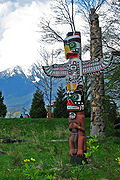
Robert Burns
Robert Burns was a Scottish poet and a lyricist. He is widely regarded as the national poet of Scotland, and is celebrated worldwide...
, Olympic
Olympic Games
The Olympic Games is a major international event featuring summer and winter sports, in which thousands of athletes participate in a variety of competitions. The Olympic Games have come to be regarded as the world’s foremost sports competition where more than 200 nations participate...
runner Harry Jerome
Harry Jerome
Henry "Harry" Winston Jerome, was a Canadian track and field runner. He was the grandson of John Howard, a railway porter who represented Canada in the 1912 Summer Olympics....
, and President Harding
Warren G. Harding
Warren Gamaliel Harding was the 29th President of the United States . A Republican from Ohio, Harding was an influential self-made newspaper publisher. He served in the Ohio Senate , as the 28th Lieutenant Governor of Ohio and as a U.S. Senator...
; plaques commemorating the wreck of the SS Beaver
Beaver (steamship)
Beaver was the first steamship to operate in the Pacific Northwest of North America. She made remote parts of the west coast of Canada accessible for maritime fur trading and was chartered by the Royal Navy for surveying the coastline of British Columbia....
, the sinking of the Chehalis (a tugboat that collided with the MV Princess Victoria
MV Princess Victoria
MV Princess Victoria was one of the earliest roll-on/roll-off ferries. Built in 1947, she operated from Stranraer to Larne. During a severe European windstorm on 31 January 1953, she sank in the North Channel with the loss of 133 lives, the deadliest maritime disaster in United Kingdom waters...
off Stanley Park), Pauline Johnson
Pauline Johnson
Emily Pauline Johnson , commonly known as E. Pauline Johnson or just Pauline Johnson, was a Canadian writer and performer popular in the late 19th century...
’s burial site, and the Salvation Army
Salvation Army
The Salvation Army is a Protestant Christian church known for its thrift stores and charity work. It is an international movement that currently works in over a hundred countries....
; a replica of the RMS Empress of Japan
RMS Empress of Japan (1891)
RMS Empress of Japan, also known as the "Queen of the Pacific", was an ocean liner built in 1890-1891 by Naval Construction & Armament Co., Barrow, England for Canadian Pacific Steamships...
figurehead; a bronze statue of a Girl in a Wetsuit by Elek Imredy; and a timber-and-stump archway that replaced the original Lumbermen’s Arch built by lumber workers for a visit by the Duke of Connaught
Duke of Connaught and Strathearn
The title Duke of Connaught and Strathearn was granted by Queen Victoria of the United Kingdom of Great Britain and Ireland to her third son, Prince Arthur....
, which ultimately succumbed to rot. The original arch was a copy of the Parthenon's front, using whole trees for the columns and gable, and was originally located on the Duke's carriage route at Homer and Pender Streets before it was moved to the park. The new Lumberman's Arch was built with public washrooms and change rooms, with open-air showers adjoining the former Lumberman's Arch Pool, now a waterpark.
Gardens are also a common form of commemoration in the park. The windstorm of 2006 revealed traces of a long-forgotten rock garden in the area of the Tea House and railway, which had once been one of the park's star attractions and also one of its largest man-made objects by area. A monument to the Nisei
Nisei
During the early years of World War II, Japanese Americans were forcibly relocated from their homes in the Pacific coast states because military leaders and public opinion combined to fan unproven fears of sabotage...
of British Columbia
British Columbia
British Columbia is the westernmost of Canada's provinces and is known for its natural beauty, as reflected in its Latin motto, Splendor sine occasu . Its name was chosen by Queen Victoria in 1858...
immediately west of the Aquarium is accompanied by a planting of Japanese maple and flowering cherry and other plants from Japan
Japan
Japan is an island nation in East Asia. Located in the Pacific Ocean, it lies to the east of the Sea of Japan, China, North Korea, South Korea and Russia, stretching from the Sea of Okhotsk in the north to the East China Sea and Taiwan in the south...
.
Reflecting the view that the park should be kept in a more natural state and is already saturated, the park board has banned the erection of any further memorials. In what some have considered an exception to the ban, the park board agreed in 2006 to build a new playground at Ceperley Meadows near Second Beach honouring the victims of the Air India Flight 182
Air India Flight 182
Air India Flight 182 was an Air India flight operating on the Montreal–London–Delhi route. On 23 June 1985, the airplane operating on the route a Boeing 747-237B named after Emperor Kanishka was blown up by a bomb at an altitude of , and crashed into the Atlantic Ocean while in Irish airspace.A...
bombing. The federal government has earmarked $800,000 to build the playground, which was completed in the summer of 2007. A local historian has also suggested the appropriateness of memorials marking the sites of communities that were displaced in the making of the park at Lumbermen’s Arch (Whoi Whoi, or Xwayxway), Prospect Point (Chaythoos), Brockton Point, and Kanaka Rancherie (at the foot of Denman Street), although a formal proposal has not been put forth.
External links
- Stanley Park – Vancouver Park Board website
- Map of Stanley Park – PDF Map of Stanley Park
- Stanley Park Ecology Society
- Park Board Map showing areas damaged by December 2006 storm and related closures.
- CTV news story and video footage of aerial survey showing storm damage.
- UBC Faculty of Forestry articles and photos on the windstorm damage and restoration
- Correspondence and papers in reference to Stanley Park and Deadman's Island, British Columbia, Ottawa, Ontario, s.n.1899, Sessional Papers No. 68A, Parliament of Canada, S.E. Dawson, Queen's Printer, by Order of Parliament.
- On the Spot Zoo Story, short 1953 film about the Stanley Park Zoo, City of Vancouver Archives

